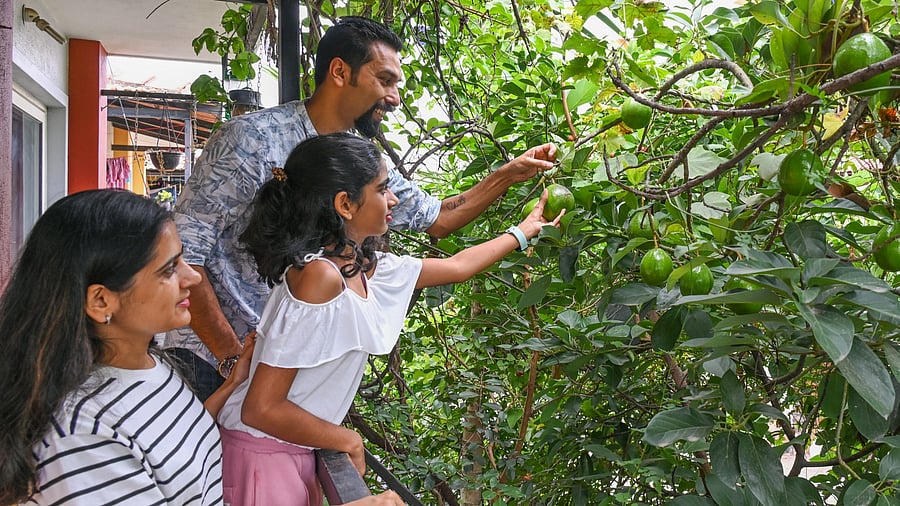
Credit: Special Arrangement.
As the years pass, kitchen gardens, front lawns and backyards have witnessed a multitude of changes. Influenced by trends and shaped by space constraints, fruiting trees have given way to smaller fruiting, flowering and ornamental plants in our cities. More recently, leaves of many shapes with fenestrations, holes and spots of many colours are all the rage and have inspired a new generation of gardeners.
For instance, the modern plant parent can be pictured with the fiddle leaf figs with their large round leaves. Or perhaps they treasure monstera, known as ‘Swiss cheese plants’, for their large fenestrated leaves. The calatheas, too, have a reputation as the ‘drama queens’ of the plant world, and some may find accomplishment in showcasing their unmarked leaves as a sign of good care.
These plants come in many sizes, shapes and colours, but they have made their way into the average city dweller’s living room. This is in part owed to the reigning home decor trend of bringing the outside in or ‘biophilic design’ — a trend that gained currency due to Covid-related movement constraints.
The design style, which originated in the 1980s, had a philosophy that most plant owners today resonate with — to foster a deeper connection with nature by populating our lived environments with life and energy.
It is this philosophy that encourages Latha Ganesh, a resident of Bengaluru, to grow roses, hibiscus and aloe vera in her front yard and on her terrace. It is the same philosophy that motivates Manasa Murari, a Bengaluru-based design professional, to grow peperomia, monstera, inch plants and philodendrons in her living room.
Manasa’s interest in plants began a little before the pandemic. Her collection largely consists of tropical plants. “Though the type of plant may have changed, there always have been ample gardeners around me — in my parents’ generation and before that,” she says.
Regardless of furnishings, Pranav Dakoria, an interior designer, thinks the inclusion of plants in our living spaces is here to stay. Most home owners today have prioritised ventilation and greenery in the household. “Even those with allergies want plants, but in their balconies,” he explains. His firm maintains a list of indoor plants that can be included with the decor.
“The clients, in fact, specify that they want oxygen-producing plants to combat pollution,” he adds.
Indoor plants have become so popular that professions like plant consultancy have emerged. Navneeth Kumar, a pandemic plant consultant, discovered that his passion for plants could also be a profession.
His job involves working with interior designers and clients to determine suitable plant species for a home. “Most people are looking for something pet-friendly. Many plants secrete this compound called oxalic acid which is toxic to anyone who ingests it,” he explains.
Deciding where plants go also can be more difficult than it seems. Each plant species has a different requirement for light, watering and humidity. “You have to examine a space at different times of the day and look at the amount of time that the clients have, take all of these factors into consideration and then make a recommendation,” he adds.
Origins
Most popular indoor plant species have origins in South America and the African continent. In these tropical forests, they grow on the floor or on tree trunks, having adapted to photosynthesise the little light that filters in from the canopies.
Dr S V Hittalmani, retired additional director (fruits), department of horticulture, explains that gardens in the past popularly featured hibiscus, jasmine and rose plants, along with guava, mango and jamun trees. “As space is on the decline, there came a need for plants that could survive in the shade. Many of these foliage ornamental plants have become popular because of this reason,” he explains.
However, the decline of fruiting trees is a matter of concern. Sumesh Nayak, a manufacturing professional who has a range of fruiting trees and indoor plants, has recognised the biodiversity that local fruiting trees are able to sustain. In fact, his home and the surrounding trees have been visited by several red-whiskered bulbuls, mynas, sunbirds and sparrows.
He believes that plant parents should exercise caution while buying plants. “Sometimes people don’t realise the time that plant care involves. People want to see results fast, but nature takes its own time,” he says.
Nayak has been gardening for nine years and has a massive collection of 2,000 plants, placed both in and around his house, to show for it. Eager to find a community, Nayak also started an Instagram page called ‘1500 sq ft gardener’. Here, he posts advice on caring for a range of different plant species.
As the pace of the city quickens and the city’s air grows heavier with pollution, residents of cities are creating oases in their homes, balconies and yards. This is a good trend, adds Nayak, “but do your research,” he adds.